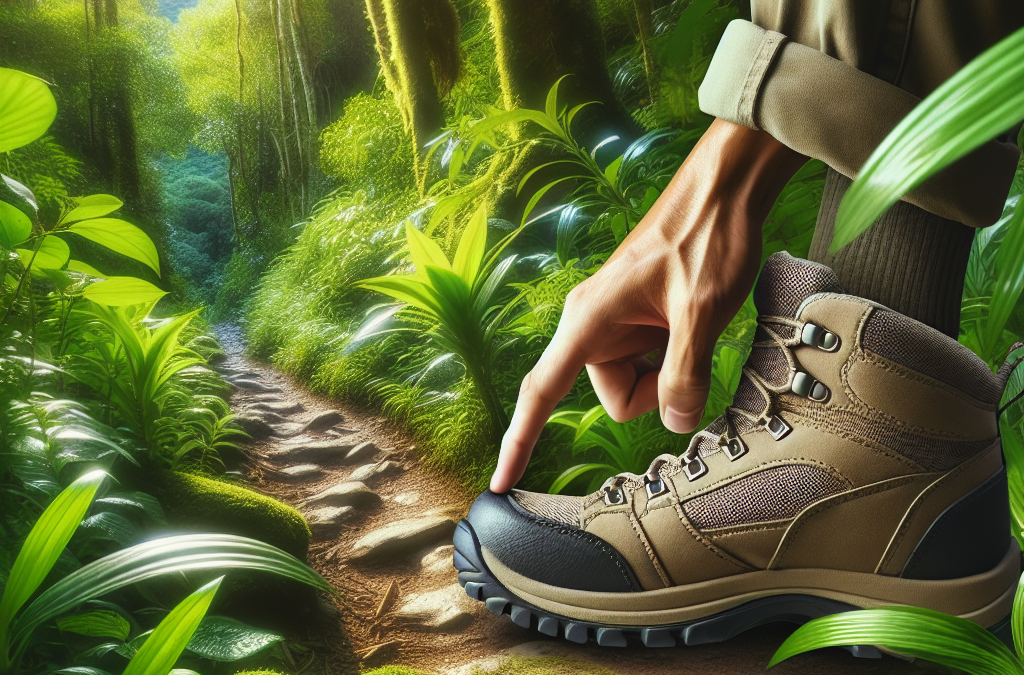Embracing the spirit of adventure while embracing responsibility towards our environment, this is the essence of “Sustainable Hiking: Leaving No Trace”. As you embark on Mother Nature’s awe-inspiring trails, it’s essential to be mindful of our impacts, striving to leave behind nothing but footprints. This article offers you the blueprint for minimizing your ecological footprint during your hikes, thereby safeguarding our planet’s breathtaking beauty for generations to come. So lace up your boots, equip yourself with your trusty backpack, and prowess from this enlightening guide to ensure your adventures are as sustainable as possible.
Understanding Sustainable Hiking
Love the great outdoors? You’re in the right place. As an enthusiastic hiker, it’s important to be part of the sustainable hiking journey, a concept that is gaining traction in recent years.
Definition of sustainable hiking
Sustainable hiking refers to hiking practices that focus on conserving resources and preserving nature while minimizing the environmental impact. It is about being conscientious about the environment, ensuring no harm is done to the ecology as we navigate through undaunted terrains and beautiful landscapes.
The importance of sustainable practices
Why should we care about sustainable hiking practices? This question amounts to asking why we should care about our planet. Our increasingly interconnected global ecosystem is facing imminent threats – be it climate change, deforestation or loss of biodiversity. These practices allow us to combat these threats one step at a time by preserving the natural environment we so deeply treasure.
The impact of unsustainable hiking on the environment
Unsustainable hiking practices can lead to soil erosion, disturbance to local wildlife, degradation of natural habitats, and increased littering. As you enjoy nature’s offerings, remember that heavy foot traffic and reckless behavior can disrupt delicate ecosystems and mar natural beauty.
Principles of Leave No Trace
the Leave No Trace framework provides us with seven principles for preserving the environment and promoting sustainability.
Overview of Leave No Trace principles
Leave No Trace principles are a set of guidelines designed to promote outdoor ethics. They are not laws or rules, but a moral compass guiding us to mitigate our footprints in nature.
Understanding each principle in depth
Planning ahead and preparing ensures we are ready to face the elements and unforeseen circumstances, while camping on durable surfaces reduces our impact on delicate ecosystems. Dispose of waste properly so as not to disrupt the natural habitat of wildlife, and leave what you find to maintain the integrity of nature. Minimize campfire impacts by opting for alternatives, respect wildlife by observing them from a distance and always remember to be considerate of other visitors to ensure a harmonious hiking experience.

Planning for Sustainable Hiking
Effective planning is instrumental in promoting and adhering to sustainable hiking principles.
The role of preparation in sustainable hiking
Preparation ensures that you have the necessary gear and knowledge to engage in sustainable practices. Given the right information, every hiker can hike responsibly and lessen their impact on the environment.
Considering hiking location and its environmental sensitivity
Understanding that different environments have different sensitivities is fundamental to minimizing your impact. Research about the flora, fauna, and landscape of your chosen location, and tailor your actions to be most appropriate for that setting.
Understanding local rules and regulations
Learn about the local rules and regulations governing hiking in your chosen location. Abide by these rules and encourage others to do the same. This will go a long way in ensuring the preservation of these cherished places.
Sustainable Hiking Gear
A critical yet often overlooked aspect of sustainable hiking is the gear you use.
The importance of selecting sustainable hiking gear
choosing sustainable hiking gear not only reduces your ecological footprint but also supports businesses that prioritize environmental protection. Select gear that is made from recycled materials, designed to last long, and can be repaired or repurposed.
How to identify eco-friendly hiking equipment
Look for gear that is made from recycled or sustainably sourced materials, and gear that has a minimal manufacturing footprint. Read labels carefully and make sure your purchase aligns with your sustainable values.
Tips for maintaining and repairing hiking gear to prolong lifespan
Proper care and maintenance of your gear can dramatically increase its lifespan, reducing the need for replacements. Clean your gear after each use, store it properly, and repair minor damages promptly.

Minimizing Impact during Hiking
Once you’ve established your hiking plan and gear, the responsibility of sustaining nature directly rests on your shoulders when you’re hiking.
Steps to minimize physical impact on nature during hiking
Stick to designated trails, camp on durable surfaces, and avoid stepping on delicate vegetation. All these simple steps go a long way in preserving nature’s integrity.
Managing hiking trails to avoid damaging flora and fauna
Trails are designed to sustain foot traffic. Straying away not only risks your safety but harms plant life and wildlife habitats. Always stay on the trail.
The concept of ‘hiking softly’
Hiking softly refers to moving through nature in a manner that minimizes your impact. Following all Leave No Trace principles is an excellent way to hike softly and responsibly.
Maintaining quiet to minimize disturbance to wildlife
Keeping your noise levels low mustn’t be overlooked. Noise can distress wildlife – remember, you’re visiting their home. Appreciate nature’s sounds, and keep your conversations and music volume low, fostering a peaceful environment.
Waste Management on Hiking Trails
One of the most noticeable impacts of hiking is improper waste disposal.
Understanding why proper waste disposal is crucial
Improper waste disposal not only mars the beauty of nature but can also harm wildlife and pollute water sources. Ensuring you dispose of waste properly maintains a clean environment for all.
‘Pack it in, pack it out’: managing solid waste
This is the golden rule when it comes to solid waste management in hiking. Whatever you bring onto the trail should leave with you. Don’t leave trash behind.
Responsible disposal of human waste
Proper disposal of human waste is crucial for maintaining sanitation and preserving water quality. Make sure you dig a deep hole far from any water bodies and pack out toilet paper.
Food and Water Management for Sustainable Hiking
Closely related to waste management is food and water management.
Choosing sustainable food and water supply options
Opt for foods with minimal packaging that will create less waste. An excellent method for water supply is using a refillable bottle with filters to purify natural sources along the trail.
Reducing food waste on trails
Minimize food waste by planning your meals wisely. Carry only what you’ll eat.
Safe and sustainable water sourcing methods
Use water purification methods to safely drink from natural water bodies like streams and lakes. Not only is this sustainable, but it also reduces the weight of your backpack.
Fire Management in Hiking
Fire affects natural ecosystems; hence it’s important to mitigate its impact.
Understanding the impact of fires on ecosystems
Fire leaves a lasting effect on landscapes. It contributes to deforestation, soil erosion, and loss of habitats. It’s up to us to ensure we minimize these risks.
Alternatives to campfires
Portable camp stoves are great alternatives to campfires. They are safer, leave no trace, and boil water faster than a campfire.
Safety tips for managing campfires where allowed
If you must have a campfire, keep it small, use only fallen twigs and branches, never leave it unattended, and ensure it is entirely out before leaving the site.
Respecting Wildlife on Hiking Trails
Hiking through wild habitats means we’ll be sharing spaces with wildlife.
The importance of maintaining distance from wildlife
Maintaining a safe distance from wildlife ensures their natural behavior is not disrupted. Our presence can cause unnecessary stress on them.
Feeding wildlife: harmful effects and reasons to avoid
Feeding wildlife is a serious offense. It changes their natural behaviors, making them dependent on human food and leads to human-wildlife conflicts.
Safe practices when encountering wildlife
Stay calm, make your presence known, and slowly back away. Never approach or provoke wildlife. Remember, it’s their home, and we should respect that.
Educating Others About Sustainable Hiking
Education has a vital role to play in spreading awareness about sustainable hiking.
The importance of education in promoting sustainable hiking
The more people know about sustainable hiking, the more likely they’ll be to practice it. Education ensures that everyone bears the responsibility of protecting our environment.
Approaches to spreading awareness about Leave No Trace
Educational programs, workshops, and field trainings are some ways to disseminate knowledge about Leave No Trace. Break these principles down into digestible bits for easy understanding.
Teaching children about sustainable hiking
Our children are the future. By teaching them about sustainable hiking, we’re ensuring that future generation’s respect and nurture Mother Nature, and continue our legacy of environmental stewardship.
Role of social media in promoting sustainable hiking
With the power and reach of social media, disseminating ideas about sustainable hiking has never been easier. Share pictures, tips, articles, and your experiences to inspire others to follow the same path.
In conclusion, sustainable hiking promotes responsibility beyond the trailhead. As stewards of nature, it’s our duty to hike responsibly and to encourage others to do the same. Only then can we enjoy the thrill of hiking while preserving nature’s beauty for future generations.

